Grimaud
29 January 2007
Grimaud, originally an 11th century castle and small hill-top villages, now encompasses a much larger area, including a lot of farmland, and a Mediterranean port. It is a few km from its more famous neighbour – St. Tropez.
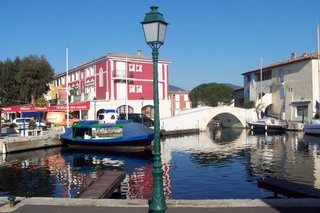 The Port de Grimaud, on the same bay as St. Tropez, was constructed in 1966 by dredging parts of the salt marshes on the Mediterranean, building or enlarging existing small islands to create a Venice-like environment of homes and canals.
The Port de Grimaud, on the same bay as St. Tropez, was constructed in 1966 by dredging parts of the salt marshes on the Mediterranean, building or enlarging existing small islands to create a Venice-like environment of homes and canals.

Unlike Venice, the homes on these canals have large motor yachts and sailboats moored on their front doorstep.
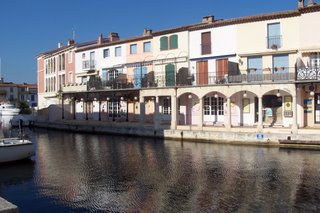
The Port covers about 220 acres and includes around 2,000 homes. Visitors must leave their cars at one of the gates at the village entrances and explore by foot.
T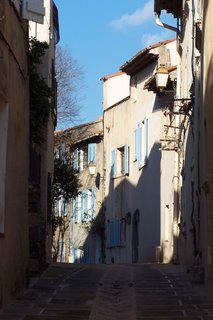 he medieval hill-top village is of course a dramatically different environment. Like most hill-top villages it seems to have been conceived and built in opposition to the notion of urban planning. But it does work. Replete with narrow, winding streets and even narrower pedestrian ways it resonates the “form follows function” school of planning combined with a heavy dose of “topography determines form”.
he medieval hill-top village is of course a dramatically different environment. Like most hill-top villages it seems to have been conceived and built in opposition to the notion of urban planning. But it does work. Replete with narrow, winding streets and even narrower pedestrian ways it resonates the “form follows function” school of planning combined with a heavy dose of “topography determines form”.
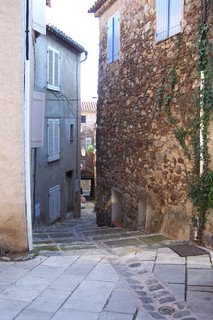
The origins of the village name are obscure. Once thought to be a derivation of the ruling Grimaldi family of Monaco, closer research has\revealed that the village name was recorded at least a century before (1058) the Grimaldi name appeared at Genoa in the 12th century and later in Provence.
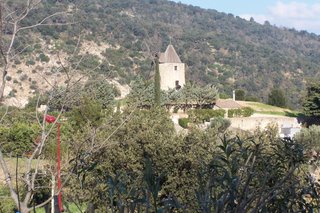
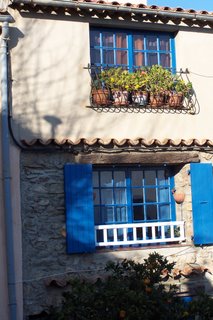
 The Château de Grimaud, now in ruins, dates to the early-mid 11th century,
The Château de Grimaud, now in ruins, dates to the early-mid 11th century,
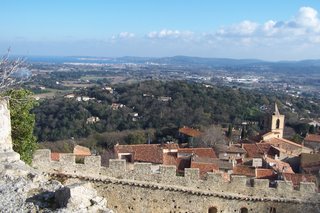
while its fortified walls encircling part of the village were built in the 13th century.
 Renovated in the 15th century it was then destroyed during the Religious Wars, rebuilt in the 17th century, and abandoned after the French Revolution.
Renovated in the 15th century it was then destroyed during the Religious Wars, rebuilt in the 17th century, and abandoned after the French Revolution.
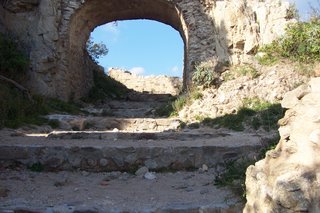
It boasted a main building flanked by two 3 story towers and was protected on two sides by the steep hill-top cliffs of its location and on the other two by walls up to 7 meters high.
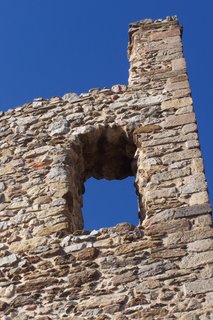
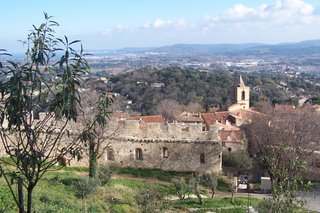 This panoramic view from its ramparts show part of its remaining walls and in the background St. Tropez and part of the gulf of that name. This commanding position explains why the gulf was historically known as the Golfe de Grimaud.
This panoramic view from its ramparts show part of its remaining walls and in the background St. Tropez and part of the gulf of that name. This commanding position explains why the gulf was historically known as the Golfe de Grimaud.
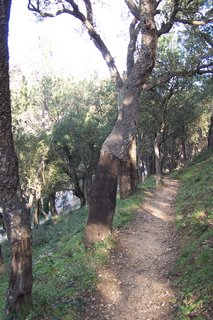
The trail up the back or the hill leading to the castle wanders through an oak cork forest that shows lots of evidence of the decennial harvesting of the bark that is used in the production of traditional wine corks. The black lower trunk is where the bark has been stripped, perhaps 5 years ago and is re-growing to be harvested in another 5 years.
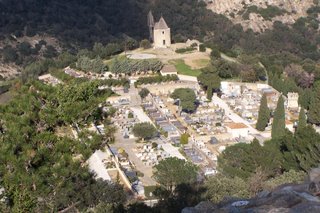
On the same side of the hill is the village cemetery, and one of several windmills used for grinding grains. A small stream in the valley behind powered 4 or 5 water-mills in the 17th century.
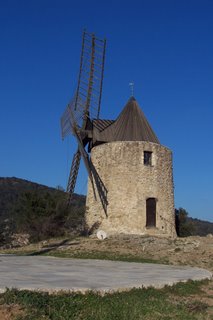

If this were la Mancha in Spain we could easily imagine Don Quijote being carried aloft by his lance caught in the blades of the windmill. Today the blades had to be content with capturing the rising moon.
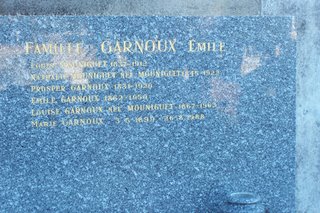 In the cemetery, Marie-Claire mentioned that she would like to have the longevity genes of this family.
In the cemetery, Marie-Claire mentioned that she would like to have the longevity genes of this family.
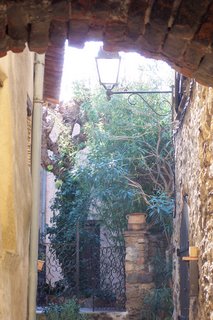
Grimaud is a picturesque town, ideal for a walking tour of about 1 to 1½ hours.
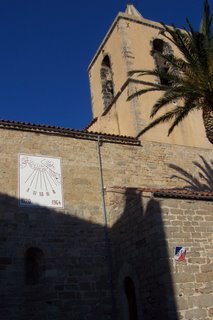
L’Ēglise Saint-Michel built in 1020 and renovated in 1964 is incredibly beautiful in its austerity and simplicity. Its current bells date to 1786 and 1866.
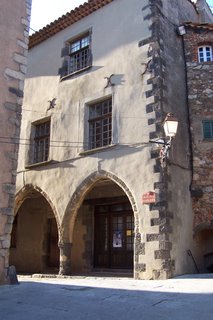 The 16th century Renaissance “Maison des Templiers”with its multiple arches.
The 16th century Renaissance “Maison des Templiers”with its multiple arches.
Grimaud, originally an 11th century castle and small hill-top villages, now encompasses a much larger area, including a lot of farmland, and a Mediterranean port. It is a few km from its more famous neighbour – St. Tropez.
 The Port de Grimaud, on the same bay as St. Tropez, was constructed in 1966 by dredging parts of the salt marshes on the Mediterranean, building or enlarging existing small islands to create a Venice-like environment of homes and canals.
The Port de Grimaud, on the same bay as St. Tropez, was constructed in 1966 by dredging parts of the salt marshes on the Mediterranean, building or enlarging existing small islands to create a Venice-like environment of homes and canals.
Unlike Venice, the homes on these canals have large motor yachts and sailboats moored on their front doorstep.

The Port covers about 220 acres and includes around 2,000 homes. Visitors must leave their cars at one of the gates at the village entrances and explore by foot.
T
 he medieval hill-top village is of course a dramatically different environment. Like most hill-top villages it seems to have been conceived and built in opposition to the notion of urban planning. But it does work. Replete with narrow, winding streets and even narrower pedestrian ways it resonates the “form follows function” school of planning combined with a heavy dose of “topography determines form”.
he medieval hill-top village is of course a dramatically different environment. Like most hill-top villages it seems to have been conceived and built in opposition to the notion of urban planning. But it does work. Replete with narrow, winding streets and even narrower pedestrian ways it resonates the “form follows function” school of planning combined with a heavy dose of “topography determines form”.
The origins of the village name are obscure. Once thought to be a derivation of the ruling Grimaldi family of Monaco, closer research has\revealed that the village name was recorded at least a century before (1058) the Grimaldi name appeared at Genoa in the 12th century and later in Provence.


 The Château de Grimaud, now in ruins, dates to the early-mid 11th century,
The Château de Grimaud, now in ruins, dates to the early-mid 11th century,
while its fortified walls encircling part of the village were built in the 13th century.
 Renovated in the 15th century it was then destroyed during the Religious Wars, rebuilt in the 17th century, and abandoned after the French Revolution.
Renovated in the 15th century it was then destroyed during the Religious Wars, rebuilt in the 17th century, and abandoned after the French Revolution.
It boasted a main building flanked by two 3 story towers and was protected on two sides by the steep hill-top cliffs of its location and on the other two by walls up to 7 meters high.

 This panoramic view from its ramparts show part of its remaining walls and in the background St. Tropez and part of the gulf of that name. This commanding position explains why the gulf was historically known as the Golfe de Grimaud.
This panoramic view from its ramparts show part of its remaining walls and in the background St. Tropez and part of the gulf of that name. This commanding position explains why the gulf was historically known as the Golfe de Grimaud.
The trail up the back or the hill leading to the castle wanders through an oak cork forest that shows lots of evidence of the decennial harvesting of the bark that is used in the production of traditional wine corks. The black lower trunk is where the bark has been stripped, perhaps 5 years ago and is re-growing to be harvested in another 5 years.

On the same side of the hill is the village cemetery, and one of several windmills used for grinding grains. A small stream in the valley behind powered 4 or 5 water-mills in the 17th century.


If this were la Mancha in Spain we could easily imagine Don Quijote being carried aloft by his lance caught in the blades of the windmill. Today the blades had to be content with capturing the rising moon.
 In the cemetery, Marie-Claire mentioned that she would like to have the longevity genes of this family.
In the cemetery, Marie-Claire mentioned that she would like to have the longevity genes of this family.
Grimaud is a picturesque town, ideal for a walking tour of about 1 to 1½ hours.

L’Ēglise Saint-Michel built in 1020 and renovated in 1964 is incredibly beautiful in its austerity and simplicity. Its current bells date to 1786 and 1866.
 The 16th century Renaissance “Maison des Templiers”with its multiple arches.
The 16th century Renaissance “Maison des Templiers”with its multiple arches.


<< Home